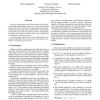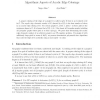116 search results - page 1 / 24 » Fast Heuristics for the Edge Coloring of Large Graphs |
DSD
2003
IEEE
13 years 10 months ago
2003
IEEE
Heuristic algorithms for coloring the edges of large undirected single-edge graphs with (or very close to) the minimal number of colors are presented. Compared to simulated anneal...
MST
2010
13 years 3 months ago
2010
Coloring a k-colorable graph using k colors (k ≥ 3) is a notoriously hard problem. Considering average case analysis allows for better results. In this work we consider the unif...
DAM
2010
13 years 4 months ago
2010
In the minimum sum edge coloring problem, we aim to assign natural numbers to edges of a graph, so that adjacent edges receive different numbers, and the sum of the numbers assign...
ICCS
2004
Springer
13 years 10 months ago
2004
Springer
In the present paper routing and wavelength assignment (RWA) in optical WDM networks is discussed. Previous techniques on based on the integer linear programming and graph coloring...
ALGORITHMICA
2002
13 years 4 months ago
2002
A proper coloring of the edges of a graph G is called acyclic if there is no 2-colored cycle in G. The acyclic edge chromatic number of G, denoted by a (G), is the least number of...


